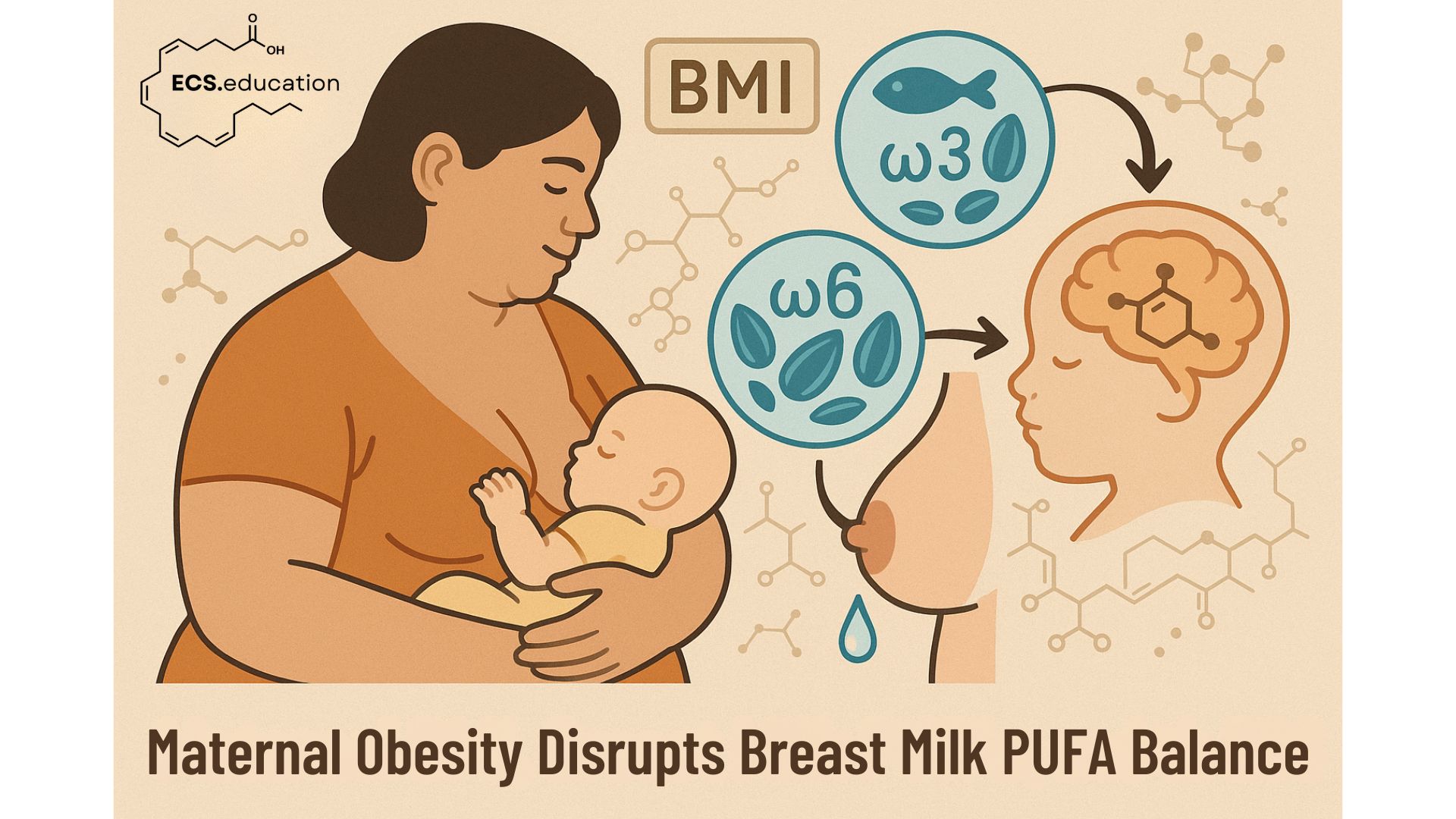Let’s dive right in. In my earlier posts on ECS.education, we’ve talked about how maternal adiposity shapes breast milk’s endocannabinoid system (ECS) and influences infant health. The May 23 piece on ‘The Adiposity Filter: How Maternal Body Fat Reshapes Milk PUFAs for Your Baby’s ECS‘ highlighted shifts in endocannabinoid profiles that affect infant appetite and growth. Then, the May 2 post on ‘Maternal Obesity Reshapes Breast Milk’s Endocannabinoid Landscape – A Missing Link in Metabolic Inheritance‘ explored how these milk signals can set up long-term metabolic patterns in babies.
Now, fresh research from Ross et al., (2025) published in Nutrients adds a new layer. It looks at how maternal body mass index (BMI) affects polyunsaturated fatty acids (PUFAs) in plasma and breast milk. These PUFAs are building blocks for endocannabinoids. The study grouped postpartum women by BMI: normal (BMI<25 kg/m2) versus overweight/obese (OW/OB, BMI≥25 kg/m2). They checked blood plasma and milk samples from foremilk to hindmilk.
What did they find? OW/OB mothers had much lower omega-3 (ω3) and omega-6 (ω6) PUFAs in their plasma, about 50% less than normal-BMI women. But in breast milk, total ω3 and ω6 levels, including precursors like alpha-linolenic acid (ALA) and linoleic acid (LA), were actually higher in both foremilk and hindmilk. The catch comes with specifics. Docosahexaenoic acid (DHA), the longest ω3 fatty acid and a key anti-inflammatory ω3, matched in foremilk but dropped sharply in hindmilk for OW/OB women. This lowered the DHA-to-total-ω3 ratio overall. Meanwhile, proinflammatory arachidonic acid (AA), the longest ω6 fatty acid, rose, pushing up the AA-to-DHA ratio. Milk DHA tracked positively with plasma levels, suggesting direct transfer. AA showed a negative correlation, pointing to changes in the mammary gland. The researchers think obesity-related insulin spikes or reactive species might block ALA’s conversion to DHA in breast tissue.
This matters because it creates uneven nutritional exposure for infants. Babies get more proinflammatory signals from higher AA and less protection from lower DHA, especially in nutrient-rich hindmilk.
Tying this to the endocannabinoid system, remember that PUFAs fuel ECS signaling. AA builds endocannabinoids like anandamide and 2-AG, which can drive inflammation or overeating if out of balance. DHA supports anti-inflammatory compounds and better ECS function. Building on my prior posts, maternal adiposity already tweaks milk ECS toward metabolic risks. Now, this skewed PUFA profile could amplify that by supplying imbalanced precursors for infant ECS development. Emerging evidence suggests that infant programming from altered AA-DHA levels in OW/OB mothers’ milk could be a key factor in why obesity runs in families, even beyond genetics. It might epigenetically tune a child’s metabolism, raising risks for inflammation, allergies, or later obesity. Broader studies link higher milk ω3 to better infant outcomes, like improved cognition, while excess ω6 ties to health drawbacks.
So, what does this mean practically? The study calls out differences in milk composition that could reprogram infants toward poorer health. The vast majority of women, and definitely all pregnant women, should supplement with omega-3 fatty acids to ensure optimal levels. OW/OB mothers might especially consider DHA supplements to counter low conversion rates. Approaches to curb AA transfer from plasma to milk, like antioxidant-rich diets, could help too.
This research reinforces that breast milk is more than food. It’s an ECS influencer shaped by maternal health. By addressing these imbalances, we might break cycles of familial non-genetic obesity.
Reference:
Ross MG, Kavasery MP, Han G, et al. Imbalance of ω3 and ω6 Fatty Acids in Breast Milk of Overweight/Obese Women. Nutrients. 2025;17(13):2158. Published 2025 Jun 28. doi:10.3390/nu17132158


Comment
Comments are closed.